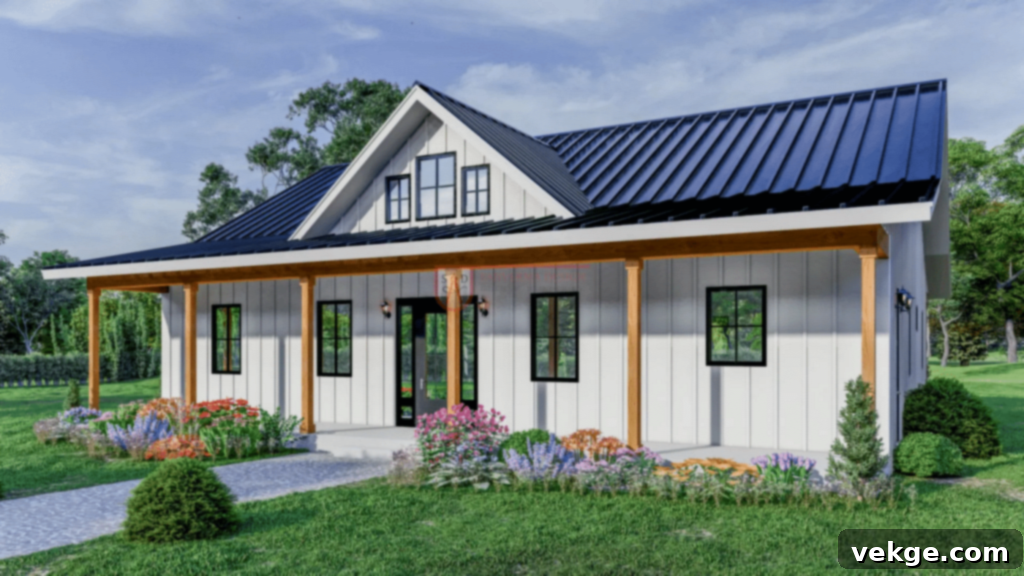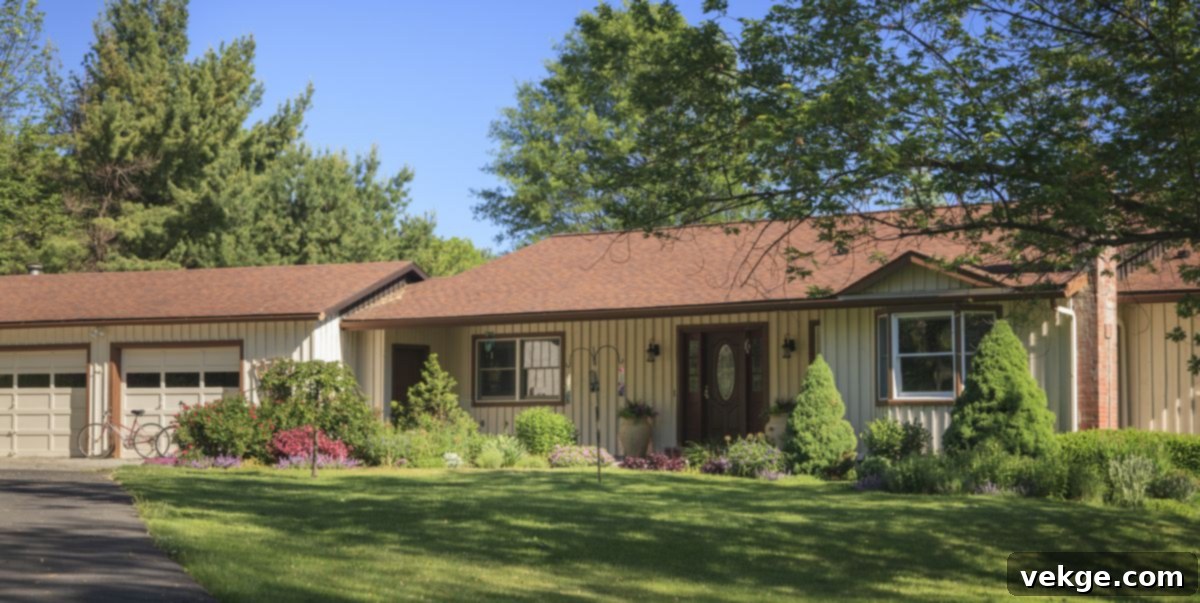Discover the Enduring Appeal: Essential Elements of Authentic Ranch-Style Homes
Ranch-style homes, a quintessential symbol of American residential architecture, embody a unique blend of practicality, understated elegance, and a seamless integration with the surrounding environment. This distinct architectural style first emerged in the 1920s, drawing its foundational inspiration from the functional and aesthetic principles of 19th-century Spanish colonial architecture. However, it ingeniously adapted these features for the evolving demands of a modern, post-war America, quickly becoming a defining look of the burgeoning suburban landscape.
Over the decades, ranch homes have naturally evolved, embracing new materials and contemporary living needs, yet their core principles remain steadfastly rooted in simplicity, expansive openness, and a profound, intimate connection to the land. This article aims to delve into the key elements that define authentic ranch architecture, shedding light on what makes this style not only distinct but also enduringly popular and adaptable to modern lifestyles.
1. The Defining Single-Story Layout

Perhaps the most immediately recognizable and defining characteristic of ranch-style homes is their straightforward single-story layout. This design choice is not merely aesthetic but deeply practical, offering unparalleled accessibility and convenience. With all living spaces on a single level, ranch homes eliminate the need for stairs, making them an ideal choice for residents of all ages and abilities, including families with young children and elderly individuals seeking barrier-free living.
The single-story structure inherently fosters a seamless and effortless flow between indoor and outdoor spaces, a true hallmark of the ranch lifestyle. This expansive footprint allows for a comfortable, sprawling feel, often incorporating L-shaped or U-shaped floor plans that embrace courtyards or private patio areas. This accessibility and inherent openness contribute significantly to the casual, comfortable, and highly desirable lifestyle that ranch homes offer, making them incredibly appealing to those who value ease of movement and a relaxed living environment.
2. The Distinctive Long, Low-Pitched Roofline
Ranch homes are instantly recognizable by their signature long, low-pitched rooflines. This distinctive architectural feature often extends significantly beyond the walls, creating a comprehensive, horizontal profile that beautifully blends with the natural landscape. The low-slung nature of the roof visually anchors the home, making it appear grounded and organically integrated with its surroundings, rather than towering over them.
Beyond its aesthetic contribution to the ranch home’s characteristic silhouette, this roof design serves numerous practical purposes. The extended eaves provide crucial shade and protection from the elements, shielding windows and walls from direct sunlight and heavy rain. This natural shading significantly enhances the home’s energy efficiency, keeping interiors cooler in warmer climates and protecting exterior finishes from weather wear. Furthermore, the low pitch is often well-suited for various climates, offering both style and durability. It’s a design element that perfectly encapsulates the ranch philosophy of form meeting function in elegant simplicity.
3. The Inviting Open Floor Plan

At the very heart of ranch architecture lies the revolutionary open floor plan, a design philosophy conceived to encourage a fluid, informal, and highly social mode of living. In these homes, traditional barriers are often removed, allowing living, dining, and kitchen areas to flow seamlessly into one another, creating large, interconnected spaces. This innovative layout deliberately eliminates unnecessary walls and partitions, fostering a sense of boundless freedom within the home.
The inherent openness of this design vastly facilitates social interaction, making ranch homes exceptionally well-suited for families who enjoy spending time together and for those who love to entertain guests. Furthermore, the absence of compartmentalization creates an expansive sense of spaciousness, making even modestly sized ranch homes feel much larger and airier. A significant benefit of the open floor plan is the generous influx of natural light, which can travel unimpeded throughout the main living areas, further blurring the lines between the indoor sanctuary and the natural beauty of the outdoors. This design perfectly reflects the post-war desire for less formal, more communal living spaces, a trend that continues to dominate modern home preferences.
4. Strong Emphasis on Horizontal Lines
Ranch-style homes are characterized by a pronounced emphasis on horizontal lines, a design principle that profoundly influences their overall aesthetic and integration with the landscape. This horizontality is evident not only in their low, sprawling layout but also meticulously woven into numerous design details. Expansive, often floor-to-ceiling windows stretch across facades, long stretches of brick or stone cladding define exterior walls, and broad, inviting patios or covered porches extend the home’s horizontal reach even further.
This deliberate emphasis on horizontal elements works in concert with the natural landscape, encouraging the eye to traverse the horizon rather than being drawn upwards. It imbues ranch homes with a sense of calm, stability, and an unpretentious grace. This visual breadth reinforces the style’s overarching themes of simplicity and accessibility, making ranch homes appear grounded, expansive, and welcoming. Unlike more vertically oriented architectural styles that command attention, ranch homes humbly spread out, becoming part of their environment rather than dominating it, thereby enhancing their unique appeal.
5. Deep Connection to the Outdoors
A fundamental element of authentic ranch architecture is its profound and deliberate connection to the outdoors. This vital characteristic is masterfully achieved through a thoughtful integration of various features designed to blend interior and exterior living spaces. Large, strategically placed windows, often picture windows or banks of windows, along with sliding glass doors, are crucial components. These elements act as transparent bridges, inviting abundant natural light and offering expansive views of the surrounding landscape, whether it be a manicured garden, a sprawling backyard, or a wilder natural setting.
Beyond mere aesthetics, this strong indoor-outdoor relationship is central to the ranch lifestyle. Patios, decks, and courtyards often extend directly from living areas, becoming open-air extensions of the home. These spaces are designed for leisure, entertaining, and simply enjoying nature, reflecting a lifestyle deeply rooted in an appreciation for natural beauty and relaxation. This seamless transition encourages residents to spend more time outdoors, fostering a sense of peace and tranquility that is a hallmark of ranch living. It’s a design philosophy that truly brings the outside in and the inside out.
6. The Elegant Minimalist Aesthetic
True to its origins in functionality and simplicity, ranch architecture embraces a distinctively minimalist aesthetic. This isn’t minimalism in a stark or cold sense, but rather a focus on clean lines, uncluttered spaces, and the inherent beauty of natural materials. Decorative details are used sparingly, if at all, ensuring that the primary emphasis remains on the home’s functional design, its architectural form, and the quality of its craftsmanship.
This minimalist approach extends seamlessly into the home’s interior, where excessive ornamentation is foregone in favor of thoughtful design and durable, authentic materials. Wood, stone, and brick are often celebrated in their natural states, providing texture and warmth without the need for intricate embellishments. The result is a home that feels timeless, serene, and genuinely comfortable. This understated elegance allows the residents’ lives and personal style to shine, making the ranch home a versatile canvas that adapts gracefully to various interior design trends while maintaining its inherent character. It’s a style that prioritizes lasting quality and practical beauty over fleeting trends.
7. Thoughtful Integration with the Landscape
Finally, a defining characteristic of authentic ranch homes is their intentional and thoughtful integration with their specific landscape. This goes beyond just having views; it involves designing the home to truly belong to its environment, whether nestled in a bustling suburb, sprawling across a tranquil countryside, or adapting to the rugged beauty of a desert. Ranch homes are often customized to blend harmoniously with their immediate surroundings, responding to local topography, climate, and available resources.
This might manifest in various ways: utilizing local stone for facades in rocky regions, adopting drought-tolerant landscaping in arid areas to conserve water, or incorporating an abundance of natural wood and fibers in forested settings to echo the surrounding trees. The sprawling, low-profile nature of ranch homes naturally lends itself to this integration, allowing the structure to follow the contours of the land rather than imposing upon it. This deep respect for nature and remarkable adaptability to different environments underscores the ranch style’s enduring legacy, making each ranch home uniquely suited to its place and demonstrating a timeless connection between architecture and nature.
Conclusion: The Timeless Appeal of Ranch Architecture
Ranch architecture, with its unwavering emphasis on simplicity, openness, and harmonious integration with the land, offers a timeless appeal that continues to resonate deeply with a diverse range of homeowners. Its foundational elements—from accessible single-story living and distinctively low-pitched roofs to expansive open floor plans and a robust indoor-outdoor connection—collectively reflect a lifestyle that cherishes comfort, promotes accessibility, and fosters a profound engagement with the natural world.
In an era where architectural styles constantly evolve and trends come and go, the authentic ranch home stands out for its remarkable ability to adapt without losing its essence. Its understated elegance, functional design, and embodiment of an inherently American spirit of ease and openness ensure its continued relevance. As we continue to explore and appreciate the rich tapestry of architectural styles, the ranch house remains a beloved icon, offering a practical, beautiful, and deeply satisfying way to live for generations to come. Its legacy is not just in its structure, but in the welcoming, unpretentious lifestyle it affords.
